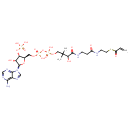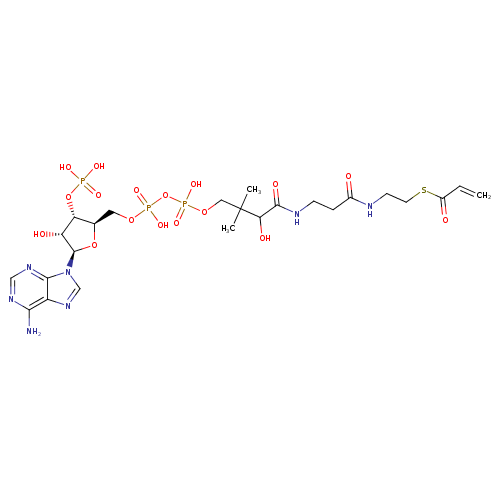|
Record Information |
|---|
| Version |
1.0 |
|---|
| Update Date |
1/22/2018 11:54:54 AM |
|---|
|
Metabolite ID | PAMDB120457 |
|---|
|
Identification |
|---|
| Name: |
acryloyl-CoA |
|---|
| Description: | Tetraanion of acryloyl-CoA arising from deprotonation of phosphate and diphosphate functions. |
|---|
|
Structure |
|
|---|
| Synonyms: | - Acrylyl-coenzymeA
- propenoyl-CoA
- acrylyl-CoA
|
|---|
|
Chemical Formula: |
C24H34N7O17P3S |
|---|
| Average Molecular Weight: |
817.551 |
|---|
| Monoisotopic Molecular
Weight: |
821.1258 |
|---|
| InChI Key: |
POODSGUMUCVRTR-IEXPHMLFSA-J |
|---|
| InChI: | InChI=1S/C24H38N7O17P3S/c1-4-15(33)52-8-7-26-14(32)5-6-27-22(36)19(35)24(2,3)10-45-51(42,43)48-50(40,41)44-9-13-18(47-49(37,38)39)17(34)23(46-13)31-12-30-16-20(25)28-11-29-21(16)31/h4,11-13,17-19,23,34-35H,1,5-10H2,2-3H3,(H,26,32)(H,27,36)(H,40,41)(H,42,43)(H2,25,28,29)(H2,37,38,39)/p-4/t13-,17-,18-,19+,23-/m1/s1 |
|---|
| CAS
number: |
5776-58-9 |
|---|
| IUPAC Name: | 3'- phosphonatoadenosine 5'- phosphonatoadenosine 5'- (3- (3- {(3R)- {(3R)- 3- 3- hydroxy- hydroxy- 2,2- 2,2- dimethyl- dimethyl- 4- 4- oxo- oxo- 4- 4- [(3- [(3- oxo- oxo- 3- 3- {[2- {[2- (prop- (prop- 2- 2- enoylsulfanyl)ethyl]amino}propyl)amino]butyl} diphosphate) enoylsulfanyl)ethyl]amino}propyl)amino]butyl} diphosphate) |
|---|
|
Traditional IUPAC Name: |
[(2R,3S,4R,5R)-5-(6-aminopurin-9-yl)-4-hydroxy-2-[({hydroxy[hydroxy(3-hydroxy-2,2-dimethyl-3-[(2-{[2-(prop-2-enoylsulfanyl)ethyl]carbamoyl}ethyl)carbamoyl]propoxy)phosphoryl]oxyphosphoryl}oxy)methyl]oxolan-3-yl]oxyphosphonic acid |
|---|
| SMILES: | C=CC(=O)SCCNC(=O)CCNC(=O)C(O)C(C)(C)COP(=O)(OP(=O)(OCC1(C(OP([O-])(=O)[O-])C(O)C(O1)N3(C2(=C(C(N)=NC=N2)N=C3))))[O-])[O-] |
|---|
|
Chemical Taxonomy |
|---|
|
Taxonomy Description | This compound belongs to the class of chemical entities known as acyl coas. These are organic compounds containing a coenzyme A substructure linked to an acyl chain. |
|---|
|
Kingdom |
Chemical entities |
|---|
| Super Class | Organic compounds |
|---|
|
Class |
Lipids and lipid-like molecules |
|---|
| Sub Class | Fatty Acyls |
|---|
|
Direct Parent |
Acyl CoAs |
|---|
| Alternative Parents |
|
|---|
| Substituents |
- Coenzyme a or derivatives
- Purine ribonucleoside 3',5'-bisphosphate
- Purine ribonucleoside bisphosphate
- Purine ribonucleoside diphosphate
- Ribonucleoside 3'-phosphate
- Pentose phosphate
- Pentose-5-phosphate
- Beta amino acid or derivatives
- Glycosyl compound
- N-glycosyl compound
- 6-aminopurine
- Monosaccharide phosphate
- Organic pyrophosphate
- Pentose monosaccharide
- Imidazopyrimidine
- Purine
- Aminopyrimidine
- Monoalkyl phosphate
- Fatty amide
- Alkyl phosphate
- Monosaccharide
- N-acyl-amine
- N-substituted imidazole
- Organic phosphoric acid derivative
- Imidolactam
- Phosphoric acid ester
- Primary aromatic amine
- Pyrimidine
- Acrylic acid or derivatives
- Oxolane
- Azole
- Imidazole
- Heteroaromatic compound
- Amino acid or derivatives
- Carbothioic s-ester
- Thiocarboxylic acid ester
- Secondary carboxylic acid amide
- Secondary alcohol
- Carboxamide group
- Oxacycle
- Azacycle
- Thiocarboxylic acid or derivatives
- Organoheterocyclic compound
- Carboxylic acid derivative
- Sulfenyl compound
- Primary amine
- Organopnictogen compound
- Organic oxygen compound
- Alcohol
- Amine
- Carbonyl group
- Organic nitrogen compound
- Organonitrogen compound
- Organooxygen compound
- Organosulfur compound
- Organic oxide
- Hydrocarbon derivative
- Aromatic heteropolycyclic compound
|
|---|
| Molecular Framework |
Aromatic heteropolycyclic compounds |
|---|
| External Descriptors |
Not Available |
|---|
|
Physical Properties |
|---|
| State: |
Solid |
|---|
| Charge: | -4 |
|---|
|
Melting point: |
Not Available |
|---|
| Experimental Properties: |
| Property | Value | Reference |
|---|
| Melting Point | Not Available | Not Available | | Boiling Point | Not Available | Not Available | | Water Solubility | Not Available | Not Available | | LogP | Not Available | Not Available |
|
|---|
| Predicted Properties |
|
|---|
|
Biological Properties |
|---|
| Cellular Locations: |
Not Available |
|---|
| Reactions: | |
|---|
|
Pathways: |
|
|---|
|
Spectra |
|---|
| Spectra: |
|
|---|
|
References |
|---|
| References: |
- OMMBID: http://genetics.accessmedicine.com/server-java/Arknoid/amed/mmbid/co_chapters/ch094/ch094_p03.html [Link]
|
|---|
| Synthesis Reference: |
Symes, Kenneth Charles; Collier, Simon Andrew; Armitage, Yvonne Christine; Mistry, Rajesh; Baranyai, Robert. Biocatalytic manufacturing of (meth)acrylic esters. PCT Int. Appl. (2007), 40pp. CODEN: PIXXD2 WO 2007039415 A1 20070412 CAN 146:400675 AN 2007:409912 |
|---|
| Material Safety Data Sheet (MSDS) |
Not Available |
|---|
|
Links |
|---|
| External Links: |
|
|---|


